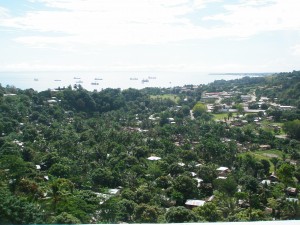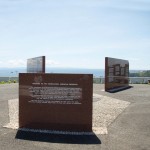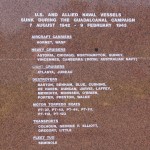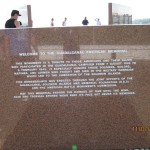 On a hill overlooking the beautiful and tranquil Pacific Ocean in Honiara, Solomon Islands stands an American Monument to the Naval and Marine Corps nightmare known as Guadalcanal. The first major United States Pacific offensive of WWII was ultimately successful, but at a cost that was horrific. Twenty-four U.S. naval vessels were lost – aircraft carriers, heavy cruisers, light cruisers, and destroyers. Their names echo in American naval history – Astoria, Hornet, Wasp, Atlanta, Cushing, Porter, Preston, Juneau, and on and on. The human cost was even higher – 1,592 Marine and Army troops and airmen killed in action – 5,041 U.S. Naval officers and sailors killed, most of those lost at sea in some of the most heroic and brutal naval combat in human history. One must add to that total the thousands of equally brave Japanese and Australians who also gave their lives in 1942 and 1943 in the tropical waters off Guadalcanal that came to be known as “Ironbottom Sound” to those who survived the carnage.
On a hill overlooking the beautiful and tranquil Pacific Ocean in Honiara, Solomon Islands stands an American Monument to the Naval and Marine Corps nightmare known as Guadalcanal. The first major United States Pacific offensive of WWII was ultimately successful, but at a cost that was horrific. Twenty-four U.S. naval vessels were lost – aircraft carriers, heavy cruisers, light cruisers, and destroyers. Their names echo in American naval history – Astoria, Hornet, Wasp, Atlanta, Cushing, Porter, Preston, Juneau, and on and on. The human cost was even higher – 1,592 Marine and Army troops and airmen killed in action – 5,041 U.S. Naval officers and sailors killed, most of those lost at sea in some of the most heroic and brutal naval combat in human history. One must add to that total the thousands of equally brave Japanese and Australians who also gave their lives in 1942 and 1943 in the tropical waters off Guadalcanal that came to be known as “Ironbottom Sound” to those who survived the carnage.
It’s been almost seven decades now – the brutality and death of the Battles of Cape Esperance and Savo Island and Tassafaronga have been replaced by the lush green background of the Solomon Island hills – and the once blood-stained waters washed clean by a deep calming blue marking the common resting place of men once mortal enemies, now resting together in peace. The words of Joseph Conrad were perhaps meant for this very place more than any other…
“May the deep where he sleeps rock him gently, gently, until the end of time.”
I encourage every reader of this blog to read James D. Hornfischer’s book “Neptune’s Inferno” to learn much more about the U.S. Navy at Guadalcanal. It is superb history, written by a master of the English language.



Manshadow said:
Hello to the Guadalcanal Memorial form Wise County Veterans of Texas! We are completing a veterans musem here under the charitable help from our communities and I presume your library also relys on public assistance with operating funds. We have in our group veterans of the Solomons Island battles who suggested I contact you with an idea to unearth some of the millions of spent, empty small arms cartridges that lie under the sands of those distand battlefields so that we might purchase them for resale. This might also be a project of interest to youth groups or other community based organizations on your island. We would be willing to pay $50 US for lots of 500 of such artifacts in recognizeable condition no matter the origin of them, either American or Japanese. Please let me know if you think this idea has merit. Best wishes to you in all you do.